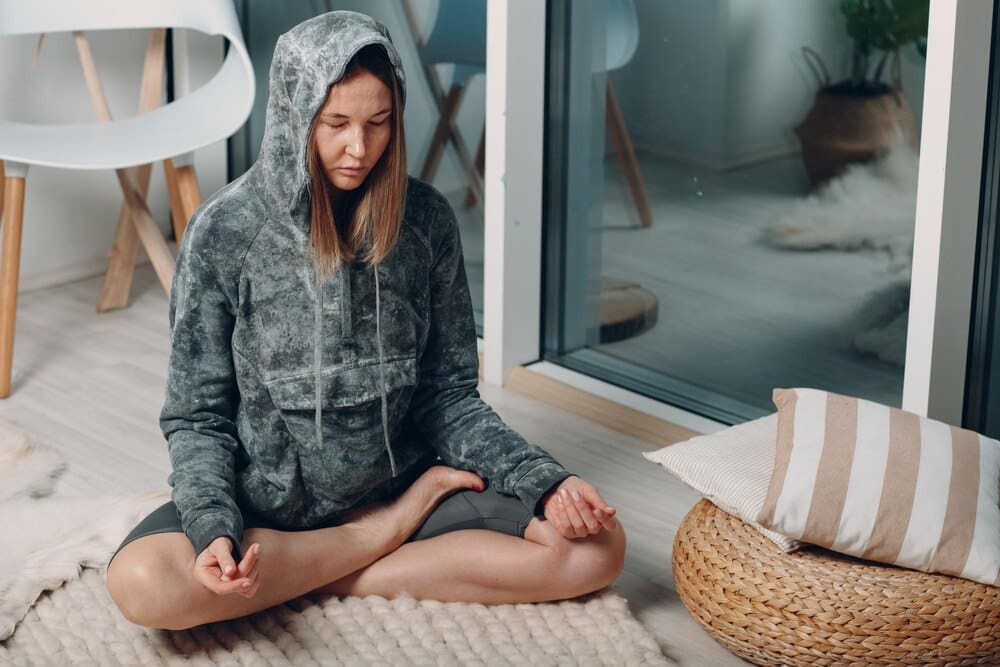For the millions of people worldwide living with anxiety, the search for relief can feel relentless. While clinical therapies and medications are cornerstones of treatment, a powerful, evidence-based tool is increasingly being recommended by mental health professionals: mindfulness meditation. This ancient practice, now backed by modern neuroscience, offers a way for anyone to manage anxiety by fundamentally changing their relationship with their own thoughts and feelings. It works by training the brain to focus on the present moment without judgment, which can interrupt the cycle of worry and fear that fuels anxiety, and it can be practiced anywhere, anytime, often in just a few minutes a day.
Understanding Anxiety’s Grip and How Mindfulness Helps
Anxiety often operates in a vicious cycle. It begins with a trigger—a stressful event, a physical sensation, or even just a stray thought. This leads to a cascade of worried thoughts and “what if” scenarios, which in turn activate the body’s sympathetic nervous system, our innate “fight-or-flight” response. This produces physical symptoms like a racing heart, shallow breathing, and muscle tension, which we then interpret as further proof that something is wrong, intensifying the initial anxiety.
Mindfulness meditation provides a crucial intervention in this cycle. It creates a space between the trigger and our reaction. Instead of being immediately swept away by anxious thoughts, we learn to observe them as temporary mental events, like clouds passing in the sky. This act of observation, without getting entangled, prevents the full-blown activation of the fight-or-flight response.
On a neurological level, this practice is not just a mental trick; it physically reshapes the brain through a process called neuroplasticity. Research has shown that regular mindfulness practice can decrease the size and reactivity of the amygdala, the brain’s alarm center that triggers the fear response. Simultaneously, it strengthens the prefrontal cortex, the area responsible for higher-order functions like emotional regulation, problem-solving, and impulse control. In essence, you are training your brain to be less reactive and more responsive.
What is Mindfulness, Really?
While often used interchangeably with meditation, mindfulness is a broader quality of awareness that can be cultivated through formal meditation and then applied to any aspect of life. It’s about paying attention, on purpose, in the present moment, and non-judgmentally. Let’s break down these core components, as they are essential for understanding how the practice works to alleviate anxiety.
Present Moment Awareness
Anxiety rarely lives in the present moment. It thrives on ruminating about past mistakes or worrying about future catastrophes. Mindfulness anchors you firmly in the “now.” By intentionally focusing your attention on the physical sensations of this very moment—the feeling of your breath, the sounds in the room, the pressure of your feet on the floor—you give your mind a job to do other than worrying.
Non-Judgment
This is perhaps the most critical and challenging component for those with anxiety. We often judge our anxious feelings as “bad,” “weak,” or “unacceptable,” and then we judge ourselves for having them. This secondary layer of judgment creates more stress and anxiety. Mindfulness teaches us to observe our thoughts and feelings with a neutral, curious attitude. The thought “I’m so anxious” is simply observed, without adding, “…and that’s terrible, I shouldn’t be feeling this way.” This radical acceptance diffuses the power of the feeling.
A Beginner’s Guide: How to Start Your Practice
The beauty of mindfulness meditation is its simplicity. You don’t need special equipment, spiritual beliefs, or hours of free time. All you need is a willingness to try. Here is a step-by-step guide to your first session.
Step 1: Setting the Stage
Find a relatively quiet place where you won’t be interrupted for a few minutes. Set a timer for a short duration, perhaps just three to five minutes to start. It’s far better to practice for three minutes consistently every day than for 30 minutes once a month.
Choose a comfortable posture. You can sit in a chair with your feet flat on the floor and your back straight but not stiff. You can also sit cross-legged on a cushion. The key is to be in a position that is both relaxed and alert, so avoid lying down at first, as it can easily lead to sleep.
Step 2: The Anchor – Focusing on the Breath
Gently close your eyes or lower your gaze. Begin by bringing your attention to your breath. The breath serves as an “anchor” to the present moment. Don’t try to change your breathing in any way; just observe it as it is.
Notice the physical sensations. Feel the coolness of the air as it enters your nostrils. Notice the gentle rise and fall of your chest or abdomen with each inhale and exhale. Rest your full attention on these simple, repetitive sensations.
Step 3: The Wandering Mind (This is Normal!)
Inevitably, your mind will wander. It will drift to your to-do list, a conversation from yesterday, or a worry about tomorrow. This is not a sign of failure. It is simply what minds do. The goal of meditation is not to have an empty mind, which is impossible. The goal is to notice when your mind has wandered.
That moment of noticing—”Oh, I’m thinking about work right now”—is a moment of pure mindfulness. You have successfully woken up from the daydream. This is the core “exercise” of the practice.
Step 4: The Gentle Return
Once you notice your mind has wandered, gently and without any self-criticism, guide your attention back to your anchor—the breath. You may have to do this five, ten, or even fifty times in a five-minute session. That’s okay. Each return is a repetition that strengthens your “mindfulness muscle.”
Step 5: Ending the Practice
When your timer goes off, slowly bring your awareness back to your surroundings. Notice the sounds in the room and the feeling of your body in the chair. Gently open your eyes. Take a moment to notice how you feel physically and emotionally, again, without judgment, before continuing with your day.
Common Challenges for Beginners and How to Overcome Them
Starting a new practice can come with hurdles. Anticipating them can help you stick with it.
“I Can’t Stop Thinking!”
This is the most common concern. Remember, the goal is not to stop thoughts but to change your relationship to them. Think of your thoughts as traffic on a busy street. Your job is not to run into the street and stop the cars, but to sit on the sidewalk and simply watch them go by.
“I Feel Restless or More Anxious.”
This is also very common. When you first sit in silence, you may become acutely aware of the anxiety and restlessness that was already there, but which you were distracting yourself from. If this happens, try shortening your sessions to just one or two minutes. You can also try a walking meditation, where you focus on the sensation of your feet touching the ground.
“Am I Doing This Right?”
There is no “perfect” meditation. If you are sitting down, intending to be present, and gently returning your focus each time it wanders, you are doing it right. The practice is about the intention and the effort, not about achieving a specific state.
Integrating Mindfulness into Daily Life (Beyond the Cushion)
Formal meditation is like training in the gym; the real benefit comes when you use that strength in your daily life. You can practice “informal mindfulness” at any time.
Try mindfully drinking your morning coffee. Instead of gulping it down while scrolling on your phone, take a moment to notice its aroma, the warmth of the mug, and the taste of each sip. You can also practice the S.T.O.P. technique when you feel a wave of anxiety rising:
- Stop what you are doing.
- Take a conscious breath.
- Observe what is happening in your mind and body.
- Proceed with more awareness and choice.
Conclusion: A Journey, Not a Destination
Mindfulness meditation is not a magic cure for anxiety, but it is a profoundly effective skill for managing it. It is a journey of learning to befriend your own mind rather than being at war with it. By consistently practicing—even for just a few minutes each day—you are not just calming yourself in the moment; you are fundamentally rewiring your brain for greater resilience, clarity, and peace. This practice empowers you to move from a state of reacting to life’s challenges to responding to them with wisdom and grace.












